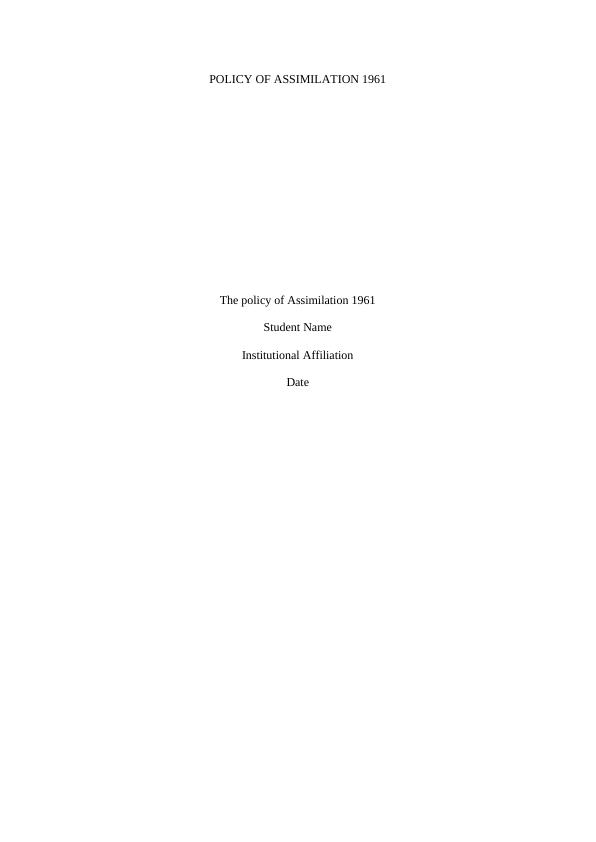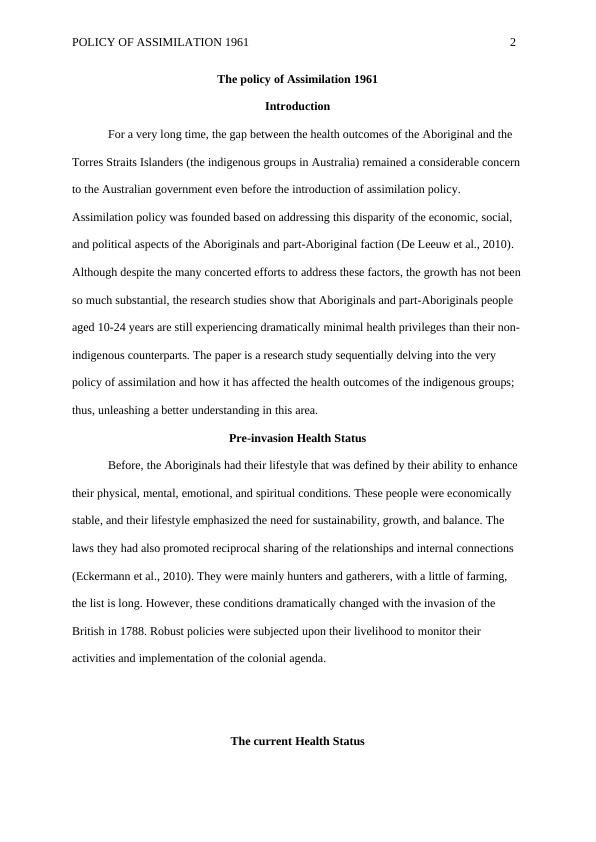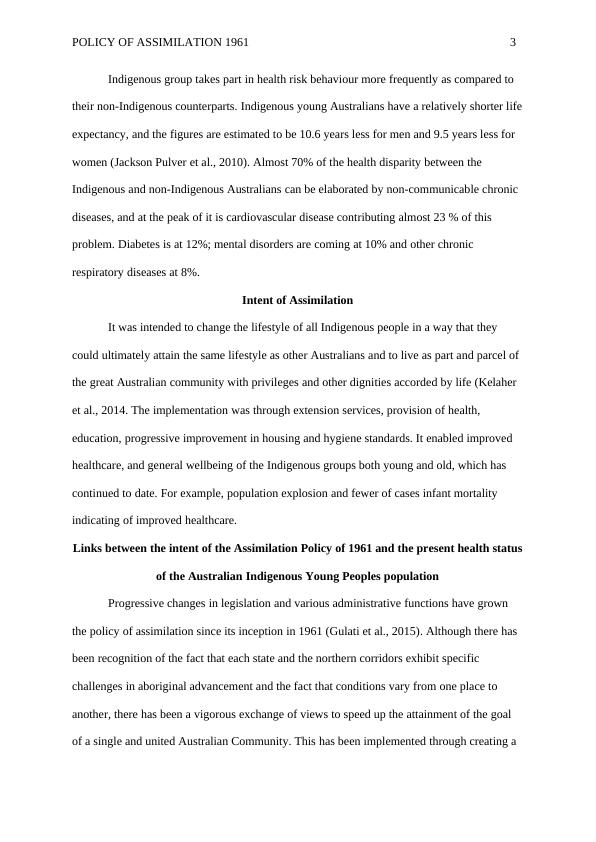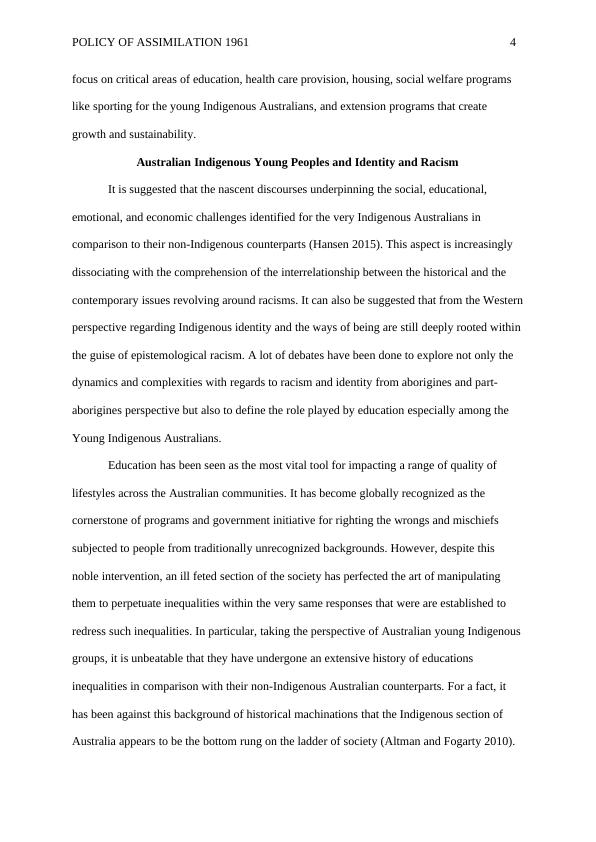Policy of Assimilation 1961: Impact on Health Outcomes of Australian Indigenous Young Peoples
Added on 2022-11-07
13 Pages3460 Words255 Views
POLICY OF ASSIMILATION 1961
The policy of Assimilation 1961
Student Name
Institutional Affiliation
Date
The policy of Assimilation 1961
Student Name
Institutional Affiliation
Date

POLICY OF ASSIMILATION 1961 2
The policy of Assimilation 1961
Introduction
For a very long time, the gap between the health outcomes of the Aboriginal and the
Torres Straits Islanders (the indigenous groups in Australia) remained a considerable concern
to the Australian government even before the introduction of assimilation policy.
Assimilation policy was founded based on addressing this disparity of the economic, social,
and political aspects of the Aboriginals and part-Aboriginal faction (De Leeuw et al., 2010).
Although despite the many concerted efforts to address these factors, the growth has not been
so much substantial, the research studies show that Aboriginals and part-Aboriginals people
aged 10-24 years are still experiencing dramatically minimal health privileges than their non-
indigenous counterparts. The paper is a research study sequentially delving into the very
policy of assimilation and how it has affected the health outcomes of the indigenous groups;
thus, unleashing a better understanding in this area.
Pre-invasion Health Status
Before, the Aboriginals had their lifestyle that was defined by their ability to enhance
their physical, mental, emotional, and spiritual conditions. These people were economically
stable, and their lifestyle emphasized the need for sustainability, growth, and balance. The
laws they had also promoted reciprocal sharing of the relationships and internal connections
(Eckermann et al., 2010). They were mainly hunters and gatherers, with a little of farming,
the list is long. However, these conditions dramatically changed with the invasion of the
British in 1788. Robust policies were subjected upon their livelihood to monitor their
activities and implementation of the colonial agenda.
The current Health Status
The policy of Assimilation 1961
Introduction
For a very long time, the gap between the health outcomes of the Aboriginal and the
Torres Straits Islanders (the indigenous groups in Australia) remained a considerable concern
to the Australian government even before the introduction of assimilation policy.
Assimilation policy was founded based on addressing this disparity of the economic, social,
and political aspects of the Aboriginals and part-Aboriginal faction (De Leeuw et al., 2010).
Although despite the many concerted efforts to address these factors, the growth has not been
so much substantial, the research studies show that Aboriginals and part-Aboriginals people
aged 10-24 years are still experiencing dramatically minimal health privileges than their non-
indigenous counterparts. The paper is a research study sequentially delving into the very
policy of assimilation and how it has affected the health outcomes of the indigenous groups;
thus, unleashing a better understanding in this area.
Pre-invasion Health Status
Before, the Aboriginals had their lifestyle that was defined by their ability to enhance
their physical, mental, emotional, and spiritual conditions. These people were economically
stable, and their lifestyle emphasized the need for sustainability, growth, and balance. The
laws they had also promoted reciprocal sharing of the relationships and internal connections
(Eckermann et al., 2010). They were mainly hunters and gatherers, with a little of farming,
the list is long. However, these conditions dramatically changed with the invasion of the
British in 1788. Robust policies were subjected upon their livelihood to monitor their
activities and implementation of the colonial agenda.
The current Health Status

POLICY OF ASSIMILATION 1961 3
Indigenous group takes part in health risk behaviour more frequently as compared to
their non-Indigenous counterparts. Indigenous young Australians have a relatively shorter life
expectancy, and the figures are estimated to be 10.6 years less for men and 9.5 years less for
women (Jackson Pulver et al., 2010). Almost 70% of the health disparity between the
Indigenous and non-Indigenous Australians can be elaborated by non-communicable chronic
diseases, and at the peak of it is cardiovascular disease contributing almost 23 % of this
problem. Diabetes is at 12%; mental disorders are coming at 10% and other chronic
respiratory diseases at 8%.
Intent of Assimilation
It was intended to change the lifestyle of all Indigenous people in a way that they
could ultimately attain the same lifestyle as other Australians and to live as part and parcel of
the great Australian community with privileges and other dignities accorded by life (Kelaher
et al., 2014. The implementation was through extension services, provision of health,
education, progressive improvement in housing and hygiene standards. It enabled improved
healthcare, and general wellbeing of the Indigenous groups both young and old, which has
continued to date. For example, population explosion and fewer of cases infant mortality
indicating of improved healthcare.
Links between the intent of the Assimilation Policy of 1961 and the present health status
of the Australian Indigenous Young Peoples population
Progressive changes in legislation and various administrative functions have grown
the policy of assimilation since its inception in 1961 (Gulati et al., 2015). Although there has
been recognition of the fact that each state and the northern corridors exhibit specific
challenges in aboriginal advancement and the fact that conditions vary from one place to
another, there has been a vigorous exchange of views to speed up the attainment of the goal
of a single and united Australian Community. This has been implemented through creating a
Indigenous group takes part in health risk behaviour more frequently as compared to
their non-Indigenous counterparts. Indigenous young Australians have a relatively shorter life
expectancy, and the figures are estimated to be 10.6 years less for men and 9.5 years less for
women (Jackson Pulver et al., 2010). Almost 70% of the health disparity between the
Indigenous and non-Indigenous Australians can be elaborated by non-communicable chronic
diseases, and at the peak of it is cardiovascular disease contributing almost 23 % of this
problem. Diabetes is at 12%; mental disorders are coming at 10% and other chronic
respiratory diseases at 8%.
Intent of Assimilation
It was intended to change the lifestyle of all Indigenous people in a way that they
could ultimately attain the same lifestyle as other Australians and to live as part and parcel of
the great Australian community with privileges and other dignities accorded by life (Kelaher
et al., 2014. The implementation was through extension services, provision of health,
education, progressive improvement in housing and hygiene standards. It enabled improved
healthcare, and general wellbeing of the Indigenous groups both young and old, which has
continued to date. For example, population explosion and fewer of cases infant mortality
indicating of improved healthcare.
Links between the intent of the Assimilation Policy of 1961 and the present health status
of the Australian Indigenous Young Peoples population
Progressive changes in legislation and various administrative functions have grown
the policy of assimilation since its inception in 1961 (Gulati et al., 2015). Although there has
been recognition of the fact that each state and the northern corridors exhibit specific
challenges in aboriginal advancement and the fact that conditions vary from one place to
another, there has been a vigorous exchange of views to speed up the attainment of the goal
of a single and united Australian Community. This has been implemented through creating a

POLICY OF ASSIMILATION 1961 4
focus on critical areas of education, health care provision, housing, social welfare programs
like sporting for the young Indigenous Australians, and extension programs that create
growth and sustainability.
Australian Indigenous Young Peoples and Identity and Racism
It is suggested that the nascent discourses underpinning the social, educational,
emotional, and economic challenges identified for the very Indigenous Australians in
comparison to their non-Indigenous counterparts (Hansen 2015). This aspect is increasingly
dissociating with the comprehension of the interrelationship between the historical and the
contemporary issues revolving around racisms. It can also be suggested that from the Western
perspective regarding Indigenous identity and the ways of being are still deeply rooted within
the guise of epistemological racism. A lot of debates have been done to explore not only the
dynamics and complexities with regards to racism and identity from aborigines and part-
aborigines perspective but also to define the role played by education especially among the
Young Indigenous Australians.
Education has been seen as the most vital tool for impacting a range of quality of
lifestyles across the Australian communities. It has become globally recognized as the
cornerstone of programs and government initiative for righting the wrongs and mischiefs
subjected to people from traditionally unrecognized backgrounds. However, despite this
noble intervention, an ill feted section of the society has perfected the art of manipulating
them to perpetuate inequalities within the very same responses that were are established to
redress such inequalities. In particular, taking the perspective of Australian young Indigenous
groups, it is unbeatable that they have undergone an extensive history of educations
inequalities in comparison with their non-Indigenous Australian counterparts. For a fact, it
has been against this background of historical machinations that the Indigenous section of
Australia appears to be the bottom rung on the ladder of society (Altman and Fogarty 2010).
focus on critical areas of education, health care provision, housing, social welfare programs
like sporting for the young Indigenous Australians, and extension programs that create
growth and sustainability.
Australian Indigenous Young Peoples and Identity and Racism
It is suggested that the nascent discourses underpinning the social, educational,
emotional, and economic challenges identified for the very Indigenous Australians in
comparison to their non-Indigenous counterparts (Hansen 2015). This aspect is increasingly
dissociating with the comprehension of the interrelationship between the historical and the
contemporary issues revolving around racisms. It can also be suggested that from the Western
perspective regarding Indigenous identity and the ways of being are still deeply rooted within
the guise of epistemological racism. A lot of debates have been done to explore not only the
dynamics and complexities with regards to racism and identity from aborigines and part-
aborigines perspective but also to define the role played by education especially among the
Young Indigenous Australians.
Education has been seen as the most vital tool for impacting a range of quality of
lifestyles across the Australian communities. It has become globally recognized as the
cornerstone of programs and government initiative for righting the wrongs and mischiefs
subjected to people from traditionally unrecognized backgrounds. However, despite this
noble intervention, an ill feted section of the society has perfected the art of manipulating
them to perpetuate inequalities within the very same responses that were are established to
redress such inequalities. In particular, taking the perspective of Australian young Indigenous
groups, it is unbeatable that they have undergone an extensive history of educations
inequalities in comparison with their non-Indigenous Australian counterparts. For a fact, it
has been against this background of historical machinations that the Indigenous section of
Australia appears to be the bottom rung on the ladder of society (Altman and Fogarty 2010).

End of preview
Want to access all the pages? Upload your documents or become a member.
Related Documents
Australian Indigenous Young Peopleslg...
|12
|3039
|262
Teaching and Learning in Aboriginal Education - SPlg...
|13
|3617
|445
Aboriginal Healthlg...
|11
|2994
|260
Impact of Health Policies on Indigenous Australians in Australialg...
|9
|2623
|239
Aboriginal and Torres Strait Island Culture PDFlg...
|11
|3107
|207
Health Care of Aboriginals and Torres Strait Islanderslg...
|12
|3195
|7
